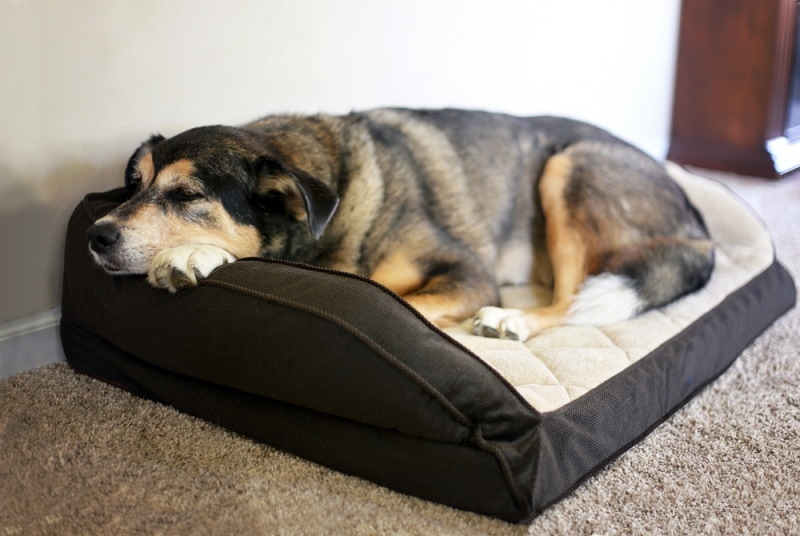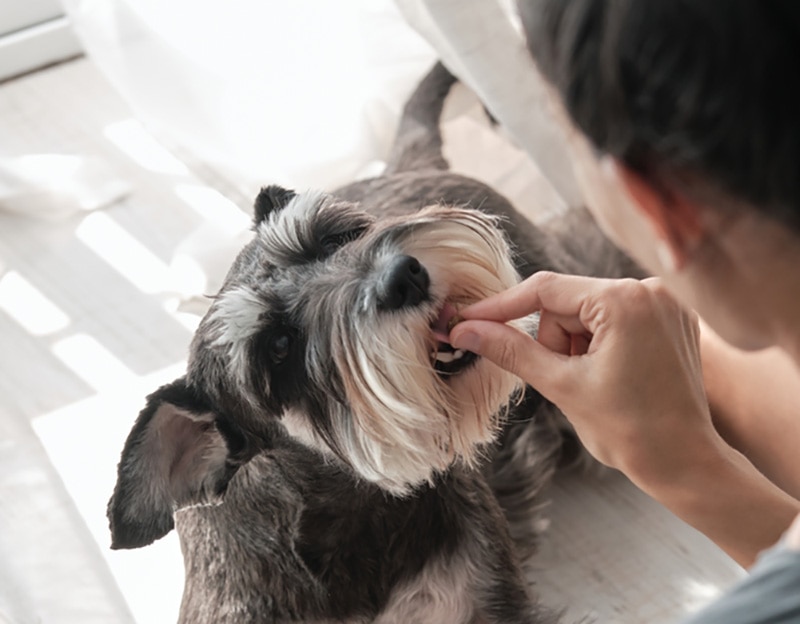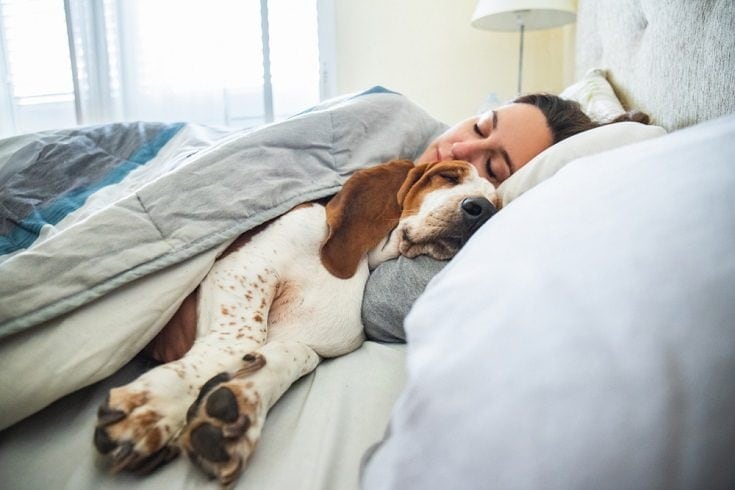How to Get a Dog to Sleep in Their Own Bed: 12 Expert Tips

Updated on

Some dogs like to doze off on the floor; others refuse to go to sleep unless it’s in your bed. And then there are canines that prefer to catch Z’s while cozied up in a crate. But what if you just bought a shiny new bed for the doggo, yet it doesn’t seem to be very excited about it? How do you change their mind?
Can you encourage the four-legged bud to sleep in its own bed? Absolutely! It’s going to take time and dedication, but it’s very much doable. You start by picking a bed, finding the perfect spot, and motivating the furry champ with treats and positive reinforcement. Read on to learn more!
The 12 Tips for Getting a Dog to Sleep in Their Own Bed
1. Establish Strict Ground Rules
No matter how much love we have for our dogs, sometimes, their cute habit of sleeping in our beds turns into a nuisance. So, the first thing you should do is decide whether you want to make your bed a “no-fly zone”, or not. Some pet parents don’t mind their furry companions hopping into their beds as long as it doesn’t happen every night; others prefer to be left alone at night.
Consistency is the most important thing in dog training. Thus, if you want to get some quality sleep without the doggo interrupting it, make sure the pet understands that it’s no longer okay for it to occupy your bedside. We’re not saying you should be rude with the pooch—on the contrary! Start implementing new house rules slowly and be equally patient, instructive, and resolute.

2. Invest in a Premium-Quality Bed
Now it’s time to pick the bed. Some canines like it when their heads are slightly “boosted”. If that’s the case with your pet, make sure a bolster is included. A senior dog or one with problematic joints will greatly benefit from an orthopedic bed. The size, shape, and firmness matter as well, of course. A consultant at a local store might be able to help you find the perfect bed for the dog.
But it would be best to know in advance what you’re looking for to avoid confusion.
3. Choose the Right Spot for It
Think about where you want to put the bed. Most pet parents like it when their dogs are sleeping next to them (like on the floor, a couple of feet away). Or, if you’d prefer to sleep all by, put the pet’s bed in the living room. Ideally, it should be the room that the doggo spends most of its waking moments in. This way, it will be much easier for it to warm up to the new bed.
Keep it away from the windows and heat sources. Also, make sure you won’t stumble over it when going to the bathroom in the middle of the night!

4. Lure the Dog in With Its Favorite Toys
Is your doggo a bit hesitant about its new bed? Don’t worry, this happens all the time. What you can do is make it as inviting as possible by putting the pet’s toys right on top of the bed. Also, don’t forget that you have a unique scent that the fur baby can easily detect.1 Go ahead and put your hands all over the bed to make it more familiar.
To further “sweeten the deal”, put the dog’s favorite blanket inside the bed, along with some tasty treats.
5. Let the Doggo Sniff Out the Bed
At this point, you should just let the dog get acquainted with the bed on its terms. Most likely, the treats, toys, and your scent will make the pet curious enough about the new purchase. If you see the dog walking around the bed, touching it, and smelling it, that’s a very good start. This is important: the pet might still be a bit standoffish, but you’re definitely on the right track.

6. Come Up With the Right Command
So, how do you make the pet go to bed? By using a special command, of course! Keep it short and simple, like “Bed” or “Go to bed”. The most important part here is, again, consistency. Do your best to ensure the dog is relaxed and ready to follow your guide. If the two of you have a strong bond and it’s an obedient doggo, this won’t take much effort.
7. Train the Dog With Treats
Don’t forget to keep the dog’s spirits high by praising it and letting it have a treat or two. Reward each successful repetition with a snack. This way, the dog will receive just the right encouragement to start using the new bed as its main sleeping spot. Also, keep the training sessions light. Here’s how you do it:
- Introduce the doggo to the bed
- Lure the dog into the bed with a treat
- Say “Bed” to instruct the bud to get it
- If the doggo jumps into the bed for the treat, praise it
- Follow that up with another treat
- Keep doing it while moving away from the dog’s bed
- Reward the dog every time it sits on the bed of its free will
- Slowly stop giving it treats and use praise instead
Keep it up, and soon the dog will happily follow the “Bed” command from across the house without any treats. Now, during the first days, if the dog runs into your bedroom in the middle of the night, command it to go back to its bed with a treat. If this happens again, only use commands, no treats. Also, don’t pay attention when it starts to whine, or else everything that you’ve been doing will be in vain!

8. Encourage the Pet to “Test-Drive” the Bed
Sometimes, dogs are quick to lie down in their new beds; in other cases, it takes a bit more time. If your pet doesn’t want to get cozied up in the bed right away, use commands like “Down” and “Stay”. Just like in the previous example, the key is to be persistent yet take it slow. Once the dog sees the bed for what it is, you won’t have to do much training or bargaining.
9. Be Patient and Supportive!
Don’t push them into the new bed. Instead, be calm and friendly, and let the doggo do something else, like relax on the couch or run around the house. Going for a walk or run with the pet is a great idea as well. The exercise will help it blow some steam and get ready for bed. Also, depending on the dog, the training process can be a bit stressful. So, by taking the edge off, you can make the process go a lot smoother.

10. Keep the Training Sessions Short
You might be compelled to teach the dog all the moves at once, but it rarely works that way. Instead, the shorter the training sessions, the easier it will be for the doggo to comply. Otherwise, you might get a bit nervous and lash out at the pet, which is NOT how this should go. And one more thing: don’t ever use the new bed as a means of punishment.
Doing that will not only make the furry companion feel bad but also create the wrong images and associations in their head. You want the bed to be the safest, most comfortable place in the entire house. On average it takes 2–5 days to train a dog how to use a new bed. If your bud catches on quickly, it might start in less than 24 hours.
11. Make the Old Sleeping Spot Unappealing
If you’re struggling to persuade the doggo, a slightly drastic measure might help. For example, you can always just lock the door to your bedroom and get some much-deserved rest. However, that might make the dog bark or howl. Spraying citrus fruits, vinegar, or pepper could help as well. Dogs hate these odors and will, most likely, stay away.

12. Talk to a Veterinarian
To be sure that your dog is not in any pain, get in touch with a vet. They’ll tell you whether there’s something to worry about or not. We’re talking about depression, separation anxiety, weak joints, or something more serious. It’s always better to play it safe. Also, if it’s a senior dog, a long walk to the new bed might be a bit tiresome for it. That’s even more true if you put it on the second floor.
Why Doesn’t My Dog Like Its New Bed? Most Common Reasons
Alright, that’s it for the main topic! Now let’s try and answer another important question: why is it that so many dogs don’t feel enthusiastic about their new beds? Is it because they’re not used to sleeping alone? Maybe the bed is making them feel uncomfortable? Here’s a closer look:

- The bed is too hot or cold. If the bed is a bit too chilly or hot for comfort, the dog won’t like sleeping in it. Thankfully, this can be fixed if you move the bed around the house until you find the right spot for it. During winter, place it near a heat source; in summer, look for the coolest spot instead.
- The bed lacks comfort. Some beds are a bit too hard, while others are extremely soft. And, since every single dog is different, it will take some trial and error before you find that perfectly crunchy bed. Or you can look for a mattress/blanket that will compensate for the bed’s overly firm or mushy nature.
- The size is not right. Nobody likes to feel cramped up while trying to get some sleep, and your dog is no exception! So, if the bed isn’t large enough, the pet will ditch it for a better spot. In contrast, a bed that’s too big will make it harder to stay warm. So, try out a bunch of “bunks” before paying for one.
- The dog needs time. This one might not be very obvious, but just like humans, dogs require some time to get used to a new environment. Be supportive, forbearing, and gentle with the fluffy family member so that it can get familiar with the new bed and start feeling comfortable in it.
Co-sharing Your Bed With the Dog: A Good Idea or Not?
There are several pros to having the doggo cozied up on the bed with you. For starters, you get to cuddle with the pooch before drifting into the Dreamland and pet it first thing in the morning. Secondly, you’ll know that it’s always there, safe and sound. Also, for some folks, this is a part of their “routine”: they can’t fall asleep without the furry bud lying on the other side. That gives them a sense of security and relieves stress.
As for the downsides, some dogs have a hard time going into deep sleep. They are “triggered” by the slightest noises and end up waking you up. And then we have chaps that drool over the bed, snore 24/7, and bark or howl. More importantly, if it’s a big, heavy dog, it might accidentally hurt you or your baby while sharing the bed. Lastly, pets often spread allergies and bacteria into the bed—keep that in mind.

To recap, the cons of letting the dog sleep in your bed include:
- You won’t get enough rest (if the dog is noisy and fidgety)
- The dog might (accidentally) cause physical injuries
- If it’s a pup, you could end up crushing it instead
- If the doggo drools, the sheets will be ruined
- The same goes for senior or incontinent dogs
- Older pets may hurt themselves trying to climb the bed
- The dog might “take over” the bed, kicking you out
- It will be much harder to train it to use a different bed
- Allergies and bacteria are other major issues
Dog Bed vs Crate: Which One Should You Choose?
For the most part, a bed is a better choice, as it gives the doggo more freedom. However, if your fluffy companion tends to get restless at night and causes a disturbance, we’d recommend opting for a crate instead. As long as it’s spacious enough and you install a comfy, cushy pad, the two of you will have a better chance of getting a good night’s sleep.

 Conclusion
Conclusion
Dogs are creatures of habit. Therefore, if you’ve been sharing your bed with a pet doggo, getting it to “ditch” the old spot for a new bed won’t be easy. No matter how fancy that bed is, most likely, the fur baby won’t even look its way. But don’t worry! With the right approach, this can be changed!
First, figure out why the dog doesn’t like the bed. Maybe it’s too cold? Or maybe you bought the wrong size? If everything checks, make the new bed nice and cozy, treat the doggo for compliance, and follow the tips from our guide. Keep at it, and the dog will fall in love with its new bed!
Featured Image Credit to: APN Photography, Shutterstock










